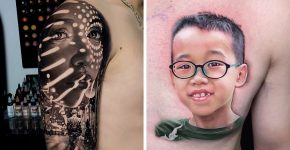Rare Black Leopard Is Photographed Emerging From The Darkness For The First Time In 100 Years In Africa
Superstitions teach us that there’s no good in a black cat crossing our path. But sometimes, it’s the contrary. Will Burrard-Lucas, a full-time wildlife photographer and the owner of Camtraptions Ltd, a photography gear company, has crossed paths with a cat so rare, that even the luckiest explorers have never encountered it. And Will even took a picture of it. In Kenya, in the county of Laikipia, on 11th of February, Will actually managed to take a series of photographs of the majestic melanistic leopard, roaming in the wild.

Image credits: Burrard-Lucas Photography
In order to achieve this, he had to set up some camera traps and wait for the creature to come closer. It’s a glorious event in the world of nature photography, because, according to Nick Pilfold, a global conservation scientist at the San Diego Zoo, the last time someone managed to take a photo of the melanistic leopard was back in 1909.

Image credits: Burrard-Lucas Photography

Image credits: Burrard-Lucas Photography
He also added that the black color of the animal’s coat is caused by a gene mutation called melanism, which leads to over-production of the pigment. The opposite phenomenon is called albinism, which turns the animals absolutely white. Yet in the photos, thanks to nighttime infrared imagery, we can see the rosette patterns in the leopard’s fur, which wouldn’t be visible to the bare eye.

Image credits: Burrard-Lucas Photography

Image credits: Burrard-Lucas Photography

Image credits: Burrard-Lucas Photography
In an interview with Bored Panda, Burrard-Lucas explained that the images were captured at Laikipia Wilderness Camp in Kenya using Camtraptions camera traps. “Each trap is made up of a Camtraptions motion sensor, which wirelessly triggers a high-quality DSLR or mirrorless camera and two or three flashes. I leave these cameras on game paths for days or even weeks at a time in order to photograph elusive animals. The technique also allows me to set up studio-like lighting in order to capture striking images of animals at night.”

Image credits: Burrard-Lucas Photography

Image credits: sandiegozooglobal
The photographer explained that one of the hardest parts was to decide where to place the camera.

Image credits: Burrard-Lucas Photography
“When I heard that a black leopard had been seen up at Laikipia Wilderness Camp in Kenya my ears pricked up and I contacted the owners, Steve and Annabelle Carey, to find out more. Steve confirmed that it was true and he had seen several black leopards over the years. On arrival in Laikipia, Steve took me to meet Luisa Ancilotto who lived close to the camp and had seen a black leopard recently. She told us as much as she knew about the leopard’s habits and territory.”

Image credits: Burrard-Lucas Photography

Image credits: Will Burrard-Lucas
Check out this behind the scenes video of this unique shoot
More info: blog.burrard-lucas.com | Facebook | Instagram | Twitter




